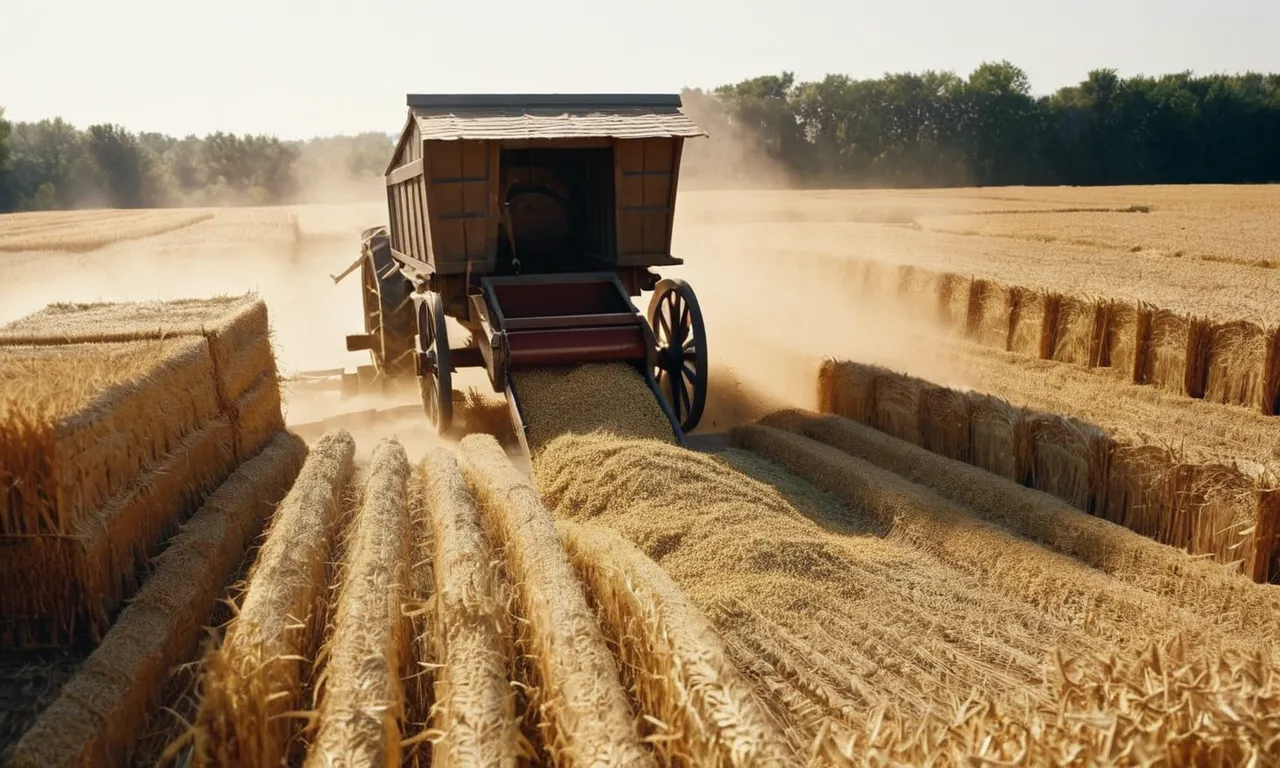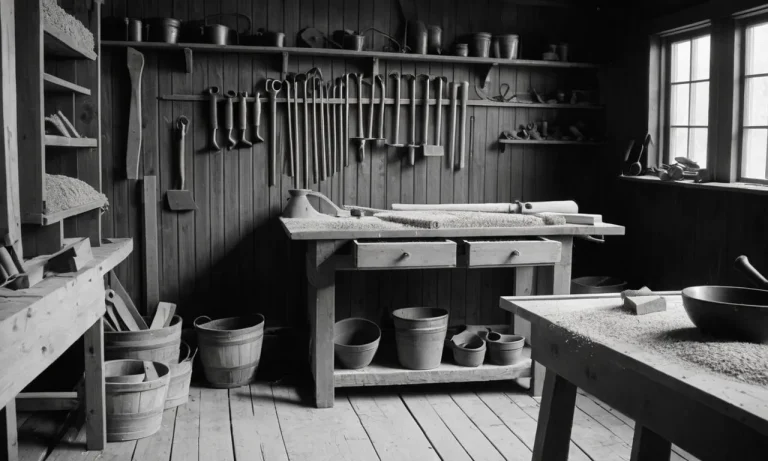What Is A Threshing Floor In The Bible?
If you have ever wondered what the Bible means when it talks about a ‘threshing floor’, you have come to the right place. Threshing floors were an integral part of agriculture in biblical times, and they are mentioned frequently throughout the Bible.
If you’re short on time, here’s a quick answer: A threshing floor was a specially prepared outdoor surface where harvested grain crops were beaten or trampled to separate the grain kernels from the straw and chaff.
Threshing floors in the Bible served both practical and symbolic purposes related to harvesting, purification, judgment, and covenant.
Definition and Purpose of a Threshing Floor
A threshing floor in the Bible was an important place for ancient communities to process their harvests of wheat and barley. Let’s explore the definition, purpose, and significance of these unique outdoor spaces.
A Place to Separate Grain from Chaff After Harvest
After crops were harvested in the field, they would be brought to the threshing floor to be threshed. Threshing is the process of separating the edible grains of wheat and barley from the inedible chaff that surrounds them.
This was typically done by spreading the harvested stalks out on the threshing floor and beating them with sticks or having oxen walk over them to crush the stalks. The loosened grains would then be tossed into the air using winnowing forks or fans so that the lighter chaff would blow away in the wind, leaving only the heavier grain kernels behind.
A Hard, Flat, Exposed Surface
Threshing floors were constructed as hard, flat surfaces, usually paved with stone, clay, or packed earth. They needed to be durable enough to withstand the trampling hooves of oxen and the repeated beating of the grain stalks.
The floors were often located on hills or other elevated sites that were exposed to more wind. The increased airflow helped blow away the chaff during winnowing.
Located Outdoors Near the Fields
Since threshing was typically done right after harvest, threshing floors were located outdoors near the fields and harvest sites. Keeping them close to the fields reduced the distance that harvesters had to carry the heavy bundles of grain stalks.
The outdoor location also provided the space and air circulation needed for the various stages of threshing and winnowing.
The Threshing Process
After the grain was harvested, ancient farmers had to separate the edible kernels of wheat, barley, and other grains from the stalks and husks. This process was called threshing, and it was one of the most labor-intensive parts of agriculture in biblical times.
Threshing involved beating the grain and then winnowing it, usually with the help of the wind. Let’s take a look at the different methods used for threshing in the Bible.
Beating the Grain
One common way to thresh grain was simply beating it with a stick, rod, or threshing tool. Ruth 2:17 mentions threshing with a staff or rod. The threshing tool was usually made of wood and was several feet long with one end flattened like a paddle.
The farmer would spread the stalks of grain onto the threshing floor and beat the heads of the grain to separate the kernels. This was very hard work and required strength and endurance!
Trampling by Animals
Another threshing method, often done along with beating, was to have oxen walk over the stalks and crush the grain out with their hooves. Deuteronomy 25:4 warns farmers not to muzzle the oxen while they are treading the grain.
Allowing the animals to eat some of the grain motivated them to crush it out efficiently with their heavy steps. Using animals was faster than beating the stalks by hand.
Winnowing With Baskets or Forks
After threshing by beating and/or animal trampling, the farmer still had to separate the crushed kernels of grain from the discarded stalks and husks, known as chaff. They would toss the threshed material into the air so that the wind could blow away the lighter chaff while the heavier grain fell back down.
Ruth 3:2 describes winnowing barley on the threshing floor. Farmers could use winnowing forks or baskets to toss the grain into the wind.
An Essential Step to Make Grain Usable
Threshing was essential to make grain edible for cooking and baking. Without removing the inedible stalks and husks, the grain would have little value as food. The Bible frequently uses imagery of threshing and winnowing to picture God separating the righteous from the wicked (Isaiah 41:16, Jeremiah 15:7).
Threshing and winnowing illustrate how God will preserve His faithful people while removing the unrepentant like chaff. Modern farming methods have machines to thresh and winnow, but in Bible times it required intense labor to thresh a harvest on the threshing floor.
Biblical References and Symbolism
Associated With Harvest and Prosperity
In the Bible, threshing floors were closely tied to harvests and agricultural prosperity. They were large, flat, hard areas where grains like wheat or barley were separated from their husks and straw (Source).
Threshing floors were often located on hills or heights to utilize wind for separating (Source). Biblical mentions like “Let me pass through your entire flock today, removing from it every speckled or spotted sheep, every dark-colored lamb, and the spotted or speckled goats” (Genesis 30:32) indicate the importance of threshing floors.
Several verses associate threshing floors with provisions, bounty, and inheritance – for example, King Solomon requesting grains and oils in Babylon’s threshing floors for his inheritance. As key locations that embodied productive harvests, threshing floors also took on wider symbolic meanings around fruitfulness and reward.
Used as a Metaphor for Judgment
Threshing floors are repeatedly invoked in a metaphorical sense to indicate judgment, often divine in nature. Verses like “At that time I will put you through a threshing process; At that time I will gather you” (Jeremiah 30:24) and “Arise and thresh, daughter of Zion, For your horn I will make iron And your hooves I will make bronze, That you may pulverize many peoples” (Micah 4:13) point to punishment and subjugation.
Here, the threshing floor’s function of separating grains from chaffs by crushing them underfoot is employed as a vivid illustration of decisive and destructive tribulation. Threshing floors therefore reflect places where difficult atonements occurred.
Covenant Between David and Araunah
One prominent story around a threshing floor involves King David’s purchase of a site from Araunah (or Ornan) the Jebusite to construct an altar to stop a plague described in 2 Samuel 24. God expressingly commands David to build the altar at Araunah’s threshing floor on Mount Moriah specifically.
Araunah offers both threshing floor and oxen for free initially, but David insists on paying to honor God by ensuring no personal benefit accrues from the altar (Source). This transaction solidified the site’s role as location of temples and sacrifices in Jerusalem for years, including the First and Second temples.
Famous Threshing Floors in the Bible
Threshing Floor of Araunah the Jebusite
One of the most famous threshing floors in the Bible is located on Mount Moriah in Jerusalem. This threshing floor belonged to Araunah (also called Ornan) the Jebusite. It was here that the angel of the Lord stopped after being sent by God to destroy Jerusalem for King David’s sin of taking a census of fighting men in Israel and Judah (2 Samuel 24:15-25).
When Araunah saw the angel, he hid. David had followed the angel to this threshing floor and offered to buy it from Araunah to build an altar and offer sacrifices to stop the plague. Araunah offered to simply give David the threshing floor and the oxen and wood for the burnt offering, but David insisted on paying for it, stating he would not offer burnt offerings to the Lord that cost him nothing.
David paid Araunah 50 shekels of silver for the threshing floor and oxen. He built an altar and offered burnt offerings and fellowship offerings there. God answered David’s prayer and stopped the plague after 70,000 people had died.
Later, David’s son Solomon would build the Lord’s temple on this same threshing floor, establishing this as a very holy site in Jerusalem (2 Chronicles 3:1).
This account shows the importance of the threshing floor as a place of meeting between God and His people. God met David at Araunah’s threshing floor, hallowing it as sacred space. Threshing floors were flat, open spaces that made convenient places for gathering, worship and sacrifice.
Though humble, this particular threshing floor became the meeting point between God and David that ended the plague on Israel. Its purchase paved the way for the temple of God to be established there in the future. This threshing floor went from mundane to sacred through God’s interaction with David.
Threshing Floor Where God Confirmed Solomon’s Temple Plans
Another key threshing floor in the Bible is found in 1 Chronicles 21. After David provided Solomon the plans for building God’s temple, Solomon began constructing it on Mount Moriah. One night, God appeared to Solomon and told him that he had chosen this place for the temple and altar.
The next day, Solomon held a large sacrifice and celebration with all of Israel on the threshing floor on Mount Moriah, the site of the future temple. God’s consuming fire came down from heaven and burned up the sacrifices, and His glory filled the temple.
This was a powerful confirmation from God that this was indeed the right place to build His temple and that He approved of the plans (1 Chronicles 21:18-26).
This account shows that like his father David, Solomon also used a threshing floor as a place of sacrifice and meeting with God. The fire from heaven was a miraculous sign that God approved of Solomon’s work and blessed the temple plans.
Though again humble, this threshing floor became holy ground where God confirmed His purposes. God met Solomon and the people of Israel on this threshing floor in a powerful way, authorizing the building of His magnificent house of worship there.
These stories reveal that threshing floors in Biblical times became important places where God interacted with His people. Though just flat spaces for threshing grain, through God’s presence and the sacrifices made there, certain threshing floors took on deep spiritual significance.
They literally bridged the gap between the realm of the holy and the mundane. As working spaces, threshing floors show that God meets us even in the midst of everyday life and labor. But they also could become sacred when God showed up in power as He did for David and Solomon.
This reminds us that God can transform even humble, workaday places into holy ground where we experience His presence and purposes.
Threshing Floors vs. Granaries, Barns and Garners
Temporary Outdoor Processing Areas
Threshing floors were outdoor areas where harvested grain crops were processed. They served as temporary work sites during harvest time rather than permanent storage facilities. After the grain was cut, it would be brought to the threshing floor to remove the edible kernels from the stalks and chaff.
The threshing process typically involved oxen or cattle trampling over the grain to separate the kernels. This was done out in the open to allow the wind to blow away the lighter chaff. Farmers might also use sledgehammers or flails to beat the grain and free the kernels.
By winnowing with a fork or fan, the lighter waste could be removed, leaving only the good grain behind in a pile.
So threshing floors were not meant for storing the finished grain crops long-term. They simply served as convenient outdoor spaces to do the hard work of initial processing during harvest time. The final edible grains would then be transported to granaries, barns or garners for proper storage and protection.
Contrast With Indoor Grain Storage
Unlike temporary threshing floors, granaries, barns and garners were specially designated buildings or chambers used for gathering and storing threshed grains for longer periods.
These indoor spaces offered protection from pests, vermin and spoilage that could ruin harvested grains. Storage containers like jars, sacks and pots would be used to contain the grains. The buildings themselves would be constructed from stone, mud brick or wood.
They would be sealed to prevent contamination or theft.
Some key differences between threshing floors and grain storage sites:
| Threshing Floors | Grain Stores |
| Outdoor spaces | Indoor buildings or rooms |
| Temporary work areas | Permanent storage facilities |
| Exposed to elements and animals | Protected from weather and pests |
| Used for initial grain processing | For gathering threshed grains |
The threshing floor’s role was transient while storage spaces ensured lasting bounty from the annual grain crops.
Conclusion
As we have seen, threshing floors in biblical history served a very practical purpose as areas to process harvested grain crops. But they also took on spiritual significance related to God’s provision, purification, judgement, and covenant blessings.
When you encounter the term ‘threshing floor’ in your Bible reading, you can reflect on both the agricultural and symbolic meaning these places held in the biblical world.








